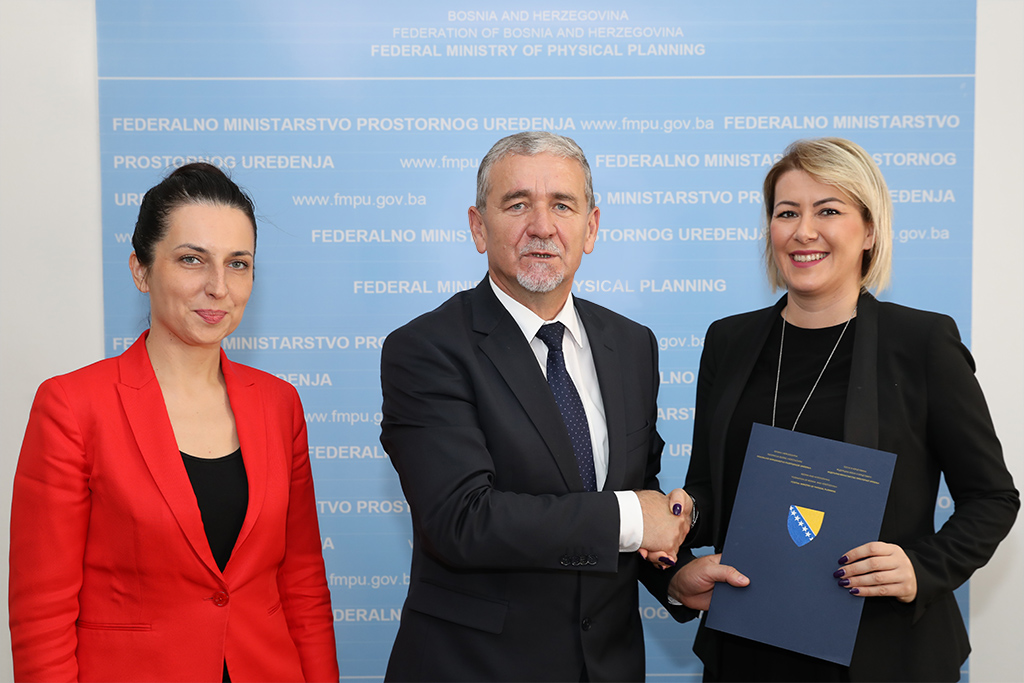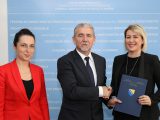Month: November 2018
Agreement signed for the Reconstruction of Five New School Buildings in the Zenica-Doboj Canton
Better conditions for students and employees of these institutions

Sarajevo, November 23rd 2018 Within the Bosnia Energy Efficiency Project (BEEP), which is implemented by the Federal Ministry of Physical Planning and financed through the World Bank credit line, another five school buildings in the Zenica-Doboj Canton will receive new energy efficient features.
On this occasion, an agreement was signed between Josip Martić, the Federal Minister of Spatial Planning in BiH and representatives of the company “ITC” d.o.o. Zenica who were selected as the official contractors of the projects.
A little more than 1,200,000 BAM will be invested in the buildings and reconstruction is expected on the following institutions: “Vladimir Nazor” Elementary School Zenica, “Gymnasium” Visoko, “Second Primary School” Zavidovići, “Stjepan Radić” Secondary School Usora, and Gymnasium “Muhsin Rizvić” Kakanj. All works will be implemented in accordance with international standards in the field of energy efficiency. After the realization of the projects, besides significant savings in energy costs, a significant reduction of CO2 emissions is expected.
“In the past period through the BEEP project, eleven facilities were renovated in the Zenica-Doboj Canton, ten of which were primary and secondary schools and one of which was a hospital. Nearly 4 million KM were invested in these facilities and savings are estimated at almost 1.4 million BAM. This alone is sufficient information to show how successful cooperation has been. I am very pleased that students and employees of these public institutions will feel an increase in comfort while savings are also expected with regards to monthly costs.” – said the Minister of Spatial Planning, Josip Martić.
Reconstruction on these facilities, which includes window replacements, thermal facade installation, roof repairs, replacement of exterior carpentry, installation of boilers that use better energy sources and replacement of existing LED lighting are expected to greatly improve conditions in these institutions.




How to Heat your Home this Winter
There has been an increasing trend in the use of energy efficient heating

With the coming of long, cold winter days, for many comes the struggle of choosing between the comfort of a warm, cozy room and the rise of their maintenance bills. That is exactly why, during this period, we follow tips and tricks about economical home heating. Moving furniture away from heat sources and lowering the temperature on our thermostat are just a few tips that are often proposed. Are we, however, considering the efficiency of our heating systems and its impact on the environment? What can we do to simultaneously save money and reduce air pollution while subsuquently reducing the amount of smog that we expect this winter?
Central and electrical heating are among the most commonly used heating systems in urban centers. It is important to note that these systems have not been changed for decades and are almost always used in apartment buildings where tenants are not given a choice. In addition to other problems that come with these forms of heating (such as the inability of regulating temperatures and high costs), both these heating systems are also enormous air pollutants.
On the other hand, in rural areas where there are almost no gas pipelines, we mostly encounter wood heating, which is used by 42 percent of the Western Balkans. Just like the previously mentioned heating systems, even wood heating does not always offer the possibility of setting temperatures, but low wood prices are one of the main reasons why people still prefer this option.
At the same time, experts advise that instead of the listed traditional heating methods, we need to use renewable energy sources such as pellets.
Pellets in particular are obtained from different types of organic material such as sawdust and are produced under extremely high pressure. Due to this process, chemicals are not added to the mass and pellets are considered to be the cleanest fuel for everyday use, completely harmless to human health and the environment.
Currently, the biggest barrier in transitioning to heating with renewable energy sources such as pellets is the cost of furnaces that burn them which range from about 2,500 KM upwards. This investment in the long run represents significant savings for the household and drastically contributes to the reduction of air pollution, said Jasmina Katica, Head of the Department for Energy Efficiency in the Federal Ministry of Physical Planning. She added “Energy efficiency today is an important issue locally and internationally. Everyone of us who uses non-renewable energy sources such as gas or coal contributes to the increase in atmospheric pollution directly or indirectly. Implementing energy efficiency measures reduces electricity and heating bills and also enables us to reduce CO2 emissions, thus increasing the quality of the natural environment.”
There is also encouraging statistical data from the European Biomass Association AEBIO, which lists BiH as the fastest growing economy with regard to the use of biomass in Europe, and compared to last year, the production of certified pellets has increased by as much as 20 percent.
Of course, it is also important to note that there are other energy efficiency measures that also help save energy and protect the environment, such as thermal insulation of walls, as well as the use of energy efficient windows and doors.
The Federal Government approved the continuation of the Bosnia Energy Efficiency Project (BEEP)
The World Bank approves the use of credit funds

Sarajevo, 20.11.2018 The Federal Government has approved a loan for the Federation of BiH under the Loan Agreement between BiH and the International Bank for Reconstruction and Development (IBRD), a World Bank institution, for the implementation of the Bosnia Energy Efficiency Project in the amount of slightly over 16 million euros. This makes up 60 percent of the total amount of approved funds for BiH which amounts to almost 30 million euros.
The development goal of this project is to demonstrate the advantages of improving energy efficiency in public sector facilities and to support the development of flexible finance models. In the past two years within the BEEP project, 37 facilities from the public sector have been renovated, of which 24 are educational institutions, 8 are health institutions, and 5 are public facilities. Through the implementation of energy efficient measures, a total of 18,347,847.22 KM was invested, while savings are estimated at 2,022,270.1 KM, and CO2 emissions were reduced by 4,900.6 (t /yr).
In addition to financial savings, significant social benefits such as warmer rooms, better lighting and better air quality were achieved. This contributes to reducing health problems and improving conditions for users. Ultimately, it is estimated that 400,000 people have benefited from the implementation of energy efficiency measures in public sector facilities in the Federation of BiH.
The loan has been approved with a maturity of 32 years, with an additional seven-year grace period.
Mr. Esad Ćorović, director of Primary School “Musa Ćazim Ćatić” Zenica: “By implementing the energy efficiency measures, in the central building only, we saved up to 30 percent.”
The results of the implementation of energy efficient measures under the BEEP Project are already noticeable

“Musa Ćazim Ćatić” Primary School from Sarajevo is one of the educational institutions on whose facility energy efficiency measures were implemented as a part of the BEEP project (B&H Energy Efficiency Project). Through measures, such as apertures replacement, installation of radiator valves with thermostatic heads, installation of equipment for measuring energy consumption and equipment for monitoring temperature and humidity, 455.782 BAM (with VAT) was invested.
As the aim of the project is not only investment in energy efficiency measures, but also raising awareness of the topic, educational and entertaining workshops are organized within the project. The main character of these workshops is the super hero Beepster, who comes from another planet to convey a message about the importance of energy efficiency to students. Thus, students have the opportunity to learn about the importance of the topic, but also get practical advice in a fun way.
Renovation on this building has been finished in 2016 and through a brief interview, the director of the school, Mr. Esad Ćatović talks about the importance of the implemented work, as well as the reactions of the employees, students and parents.
- What are the main problems that the primary school “Musa Ćazim Ćatić” Zenica faced in terms of energy consumption?
Esad Ćorović: The problems we faced were extremely old heat pipes and radiators. They were so old they would often crack, causing the suspension of heating and damage to flooring.
- What works were implemented in Your school as a part of the Beep Project and what is the importance of the implemented measures for students and employees?
Esad Ćorović: In our school, within the energy efficiency project, a calorimeter was installed on the substation as well as the valves for regulating the radiators. Implementation of these measures has been very important for pupils and school workers.
- In addition to improving the working conditions for students and teachers, did the implementation of energy efficiency measures contribute to cost reduction and financial savings?
Esad Ćorović: With the implementation of the energy efficiency project, savings are significant. In our central school, savings are up to 30%.
- What are the reactions of students and parents – are they satisfied with the work done and do they feel concrete improvements?
Esad Ćorović: We are satisfied with the work of the project implementation unit. The responses of students and parents are positive. They often emphasize their satisfaction with both the outward appearance of the school and the internal mechanisms.
- Within the BEEP project, Beepster educational workshops have been organized in Your school. How much do you think children are learning about energy efficiency in class? Do You think the curriculum provides enough information? What kind of education can help raising their awareness and making their behaviour more energy efficient?
Esad Ćorović: In certain classes, within the curriculum and extracurricular activities, students are educated on energy issues. However, I believe that education of students could be even better through organizing workshops, presenting video material, forming student teams for recording the effects of energy efficiency and similar.
Mrs. Nedžma Buza, director of “Hamdija Kreševljaković” Elementary School in Kakanj: “ The significance of implemented measures is immeasurable.”
The results of the implementation of energy efficient measures under the BEEP Project are already noticeable
 “Hamdija Kresevljakovic” Primary School from Kakanj is one of the educational institutions on whose facility energy efficiency measures were implemented as a part of the BEEP project (B&H Energy Efficiency Project). Through measures such as thermal insulation, apertures replacement, installation of thermostatic valves and improvement of central heating system, 332.627 (with VAT) was invested.
“Hamdija Kresevljakovic” Primary School from Kakanj is one of the educational institutions on whose facility energy efficiency measures were implemented as a part of the BEEP project (B&H Energy Efficiency Project). Through measures such as thermal insulation, apertures replacement, installation of thermostatic valves and improvement of central heating system, 332.627 (with VAT) was invested.
As the aim of the project is not only investments in energy efficiency measures, but also in raising awareness of the topic, educational and entertaining workshops are organized within the project. The main character of these workshops is the super hero Beepster, who comes from another planet to convey a message about the importance of energy efficiency to students. Thus, students have the opportunity to learn about the importance of the topic, but also get practical advice in a fun way.
Renovation of this building has been finished in 2016 and through a brief interview, the director of the school, Mrs. Nedžma Buza talks about the importance of the implemented work, as well as the reactions of the employees, students and parents after these works.
- What are the main problems that the primary school “Hamdija Kreševljaković” Kakanj faced in terms of energy consumption?
Nedžma Buza: The school was built in 1960. And, until the implementation of the project, a very small number of new windows was installed. That is why, in the last years, most of the heat generated during the winter was lost on worn-out carpentry. The school was connected to the city’s hot water line hence no significant drop in temperature inside the facility was felt, but that came with extremely high financial costs. At the annual level, for the consumption of thermal energy, the funds amounted to cca 75.000,00 BAM.
- What works were implemented in Your school as a part of the Beep Project and what is the importance of the implemented measures for students and employees?
Nedžma Buza: Within the BEEP project the following works were carried out:
– Thermal insulation of the exterior walls of the building
– Heat insulation of the roof of the building
– Replacement of the apperatures on the object
– Improvement of the central heating system
The significance of implemented measures is immeasurable. The goals of the project have been achieved: saving energy and saving financial resources for energy consumption. At the same time, the teaching process is now done under completely different, better conditions. The school got a new look, which also satisfied a very important, aesthetic component, both for the appearance of the school itself and its yard, as well as the whole city location.
- In addition to improving the working conditions for students and teachers, did the implementation of energy efficiency measures contribute to cost reduction and financial savings?
Nedžma Buza: After the completion of the project, in the first year alone, the school saved approximately 44.000,00 BAM on the consumption of heat energy. The savings are also measured in the field of electricity. At the same time, it is important to note that school employees and students are now educated and more responsible when it comes to energy saving.
- What are the reactions of students and parents – are they satisfied with the work done and do they feel concrete improvements?
Nedžma Buza: The school is satisfied with the work of the Federal Ministry of Physical Planning’s Implementation Unit. Through all activities, efforts were made to meet the requirements for the full implementation of the Project’s objectives. Cooperation with school management has been accomplished. There was a very correct, clear and professional climate in communication. The school’s proposals were also considered. There was a very decisive, clear and professional attitude of all the staff of the IU with whom the school was cooperating. Concrete improvements are visible and positively assessed by students and parents, as well as the entire local community.
- Within the BEEP project, Beepster educational workshops have been organized in your school. How much are children learning about energy efficiency in class? Do you think their curriculum provides enough information? What kind of education can help to raise their awareness and to make their behavior more energy efficient?
Nedžma Buza: The curriculum includes some lessons on energy efficiency, however it does not provide sufficient information. As users of this very important project, we are making efforts to educate pupils and employees in order to save and preserve everything we get.
Representatives of the World Bank satisfied with the implementation of the Energy Efficiency Project for BiH (BEEP)
Representatives of the World Bank satisfied with the implementation of the Energy Efficiency Project for BiH (BEEP)
As part of their regular activities, they visited the renovated facilities and the Federal Ministry of Physical Planning

The World Bank delegation to Bosnia and Herzegovina, comprised of energy specialists, Kathrin Hofer and Rhedon Begolli, as well as specialists of other fields, Karina Mostipan, Lamija Marijanovic, Esma Kreso, Nenad Pavlovic and Sanja Tanic, visited the Federal Ministry of Physical Planning regarding the implementation of the B&H Energy Efficiency Project (BEEP).
Within the four-day visit, together with project representatives, the delegation visited the facilities which are a part of the BEEP project, in several cities of the Federation of Bosnia and Herzegovina.
On this occasion they thoroughly analyzed the measures implemented so far and expressed their satisfaction with the results achieved. At the same time, they discussed the work plans for the next year.
Another proof of the significance of this project is the recently signed contract, through which over 1.250.000,00 BAM will be invested in the reconstruction of 3 Sarajevo schools (“Electro-technical High School”, “Fifth Elementary School” in Ilidža, and elementary school “Izet Šabić”, Sarajevo). This will give these schools a new, energy-efficient robe.
Within the B&H Energy Efficiency Project, 37 public objects have been renovated in the past two years, out of which 24 are educational, 8 are health institutions, and 5 are other public facilities. In the implementation of energy efficient measures, 18,347,847.22 BAM was invested, while savings were estimated at 2,022,270.1 BAM, and the emission of CO2 was reduced by 4,900.6 (t/yr).
In addition to savings, significant social benefits such as warmer rooms, better lighting and better air quality have been achieved. This contributes to reducing health problems and improving the conditions for users. Ultimately, it is estimated that 400 thousand users of public buildings have benefited from the increase in energy efficiency.


























